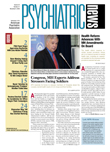A comprehensive early intervention program for first-episode psychosis—designed to provide evidence-based treatments as soon as possible after a first psychotic break—appears to be cost-effective compared with usual treatment over the long term.
Nearly eight years after initial treatment for first psychosis, annual treatment costs for each patient in an early-treatment program were on average more than $6,000 less than per-patient treatment costs for individuals receiving usual care. The report appeared in the September Schizophrenia Bulletin.
“Investment in early intervention in psychosis services is an efficient use of health care resources and is worthy of widespread implementation,” study author Cathy Mihalopoulos, a health economist at Deakin University in Victoria, Australia, told Psychiatric News.
Coauthor Patrick McGorry, M.D., Ph.D., a professor of psychiatry at Australia's University of Melbourne, added that he believes “not investing in early intervention and treatment for at least two years [following first psychosis] is economically irresponsible.”
Mihalopoulos and McGorrry studied costs associated with the Early Psychosis Prevention and Intervention Centre (EPPIC) in Melbourne. EPPIC, begun in 1992, is designed to identify patients at the earliest stage from onset of psychosis and to provide intensive phase-specific treatment for up to two years thereafter. As part of the program, a mobile team called the Early Psychosis Assessment Team (EPAT) was established to serve as the sole entry point to EPPIC. Through networking and carefully targeted community education activities, EPAT has sought to raise community awareness of psychosis in young people and promote recognition and early referral.
In the new study, direct mental health service costs incurred subsequent to the first year of treatment and symptomatic and functional outcomes of 32 participants initially treated for up to two years at EPPIC were compared with those of a matched cohort of 33 participants initially treated with usual care. Costs associated with treatment were measured using published Australian prices.
Almost eight years after initial treatment, EPPIC subjects displayed lower levels of positive psychotic symptoms, were more likely to be in remission, and had a more favorable course of illness compared with the controls. Fifty-six percent of the EPPIC cohort was in paid employment over the last two years compared with 33 percent of controls.
Moreover, each EPPIC patient cost on average $3,445 per year to treat compared with $9,503 for controls.
Mihalopoulos said the study confirms and extends the results of an initial economic evaluation of first-year costs and outcomes of treatment for patients in EPPIC. That study, published in the July 1999 Acta Psychiatrica Scandinavica, found that the first-year costs incurred by the EPPIC sample were less than those of patients treated in a model of care that prevailed in the community prior to EPPIC, with improved quality of life and fewer negative symptoms. (The earlier standard of care included enhanced inpatient care for a first episode, as in EPPIC, but with standard aftercare in the community.)
“The key reason for this difference was due to less hospital use by the EPPIC cohort,” Mihalopoulos told Psychiatric News. “Interestingly, the first EPPIC study found that the EPPIC cohort used more community-based mental health services compared to the historical controls. But our new [long-term] study found that the EPPIC cohort used less community-based outpatient services over the longer term. So the current study confirms the initial findings with the observation that community service use also seems to reduce over the longer term.”
There are some 200 early-intervention programs for first psychosis in Europe, the United Kingdom, and North America, according to the authors, but Mihalopoulos and McGorry said they know of no studies of cost-effectiveness of programs in North America. Mihalopoulos cautioned that cost-effectiveness across programs is difficult or impossible to determine, since costs for similar services can differ dramatically across different countries and health care systems.
Nevertheless, the several studies of cost-effectiveness that exist for European and United Kingdom programs all show significant reductions in cost for the early-intervention programs.
Mihalopoulos added that one study by Knapp and colleagues comparing costs of schizophrenia care in five European countries found that inpatient costs seem to vary less than other costs. That study, “Comparing Patterns and Costs of Schizophrenia Care in Five European Countries: the EPSILON Study,” appeared in the January 2002 Acta Psychiatrica Scandinavica.
“This suggests that early psychosis interventions are likely to be of benefit in Western countries that have a mix of inpatient, outpatient, and community services available,” she said. “So while the degree of cost savings may vary from system to system, there are compelling reasons to believe that such savings are possible anywhere.”
